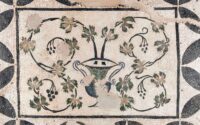 The Domus Aventino is a high-end condominium complex offering all technology, comfort, amenities, energy efficiency and round-the-clock of new construction in the historic surroundings of Piazza Albania at the foot of Rome’s Aventine Hill. Three buildings, built in the 1950s and for decades headquarters of a bank, were converted into 180 luxury apartments and penthouses. Installation of new earthquake-resistant foundations in 2014 revealed ancient remains which were excavated by archaeologists from the Special Superintendency of Rome. Elaborate mosaic floors from an Imperial-era villa demonstrated that the luxury dwellings of modern Rome stood on two hundred years of luxury dwellings of ancient Rome.
The Domus Aventino is a high-end condominium complex offering all technology, comfort, amenities, energy efficiency and round-the-clock of new construction in the historic surroundings of Piazza Albania at the foot of Rome’s Aventine Hill. Three buildings, built in the 1950s and for decades headquarters of a bank, were converted into 180 luxury apartments and penthouses. Installation of new earthquake-resistant foundations in 2014 revealed ancient remains which were excavated by archaeologists from the Special Superintendency of Rome. Elaborate mosaic floors from an Imperial-era villa demonstrated that the luxury dwellings of modern Rome stood on two hundred years of luxury dwellings of ancient Rome.
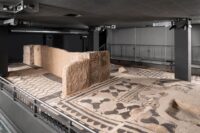 There is evidence of human occupation at the site going back to the prehistory of Rome, the 8th century B.C. when legend has it Romulus founded the city. The excavation also unearthed a wall of volcanic tufa blocks that may have bene the base of a guard tower built between the 4th and 3rd century B.C. when the Servian Wall was constructed looping around the foot of the Aventine Hill. Just a few steps away on the Viale Aventino is an extremely rare surviving archway from this wall in which a throwing weapon like a ballista or a catapult could be positioned to defend against marauders.
There is evidence of human occupation at the site going back to the prehistory of Rome, the 8th century B.C. when legend has it Romulus founded the city. The excavation also unearthed a wall of volcanic tufa blocks that may have bene the base of a guard tower built between the 4th and 3rd century B.C. when the Servian Wall was constructed looping around the foot of the Aventine Hill. Just a few steps away on the Viale Aventino is an extremely rare surviving archway from this wall in which a throwing weapon like a ballista or a catapult could be positioned to defend against marauders.
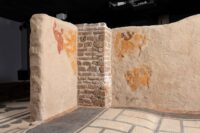 The site seems to have first changed from public defensive structure to private use around the middle of the 2nd century B.C., although the material from this period is too sparse to determine how it was used. Within this large perimeter, the floorplan of a domus emerged with identifiable areas for sleeping and for daytime use, storage areas and open-air gardens. Over the two centuries, six levels of floors were superimposed on each other. The full stratigraphic record was brought to light in one location of the house, and analysis of the six layers found that the home was restructured about every 30 years. Every generation put its stamp on this villa, altering it and refurbishing it to meet new needs and fashions.
The site seems to have first changed from public defensive structure to private use around the middle of the 2nd century B.C., although the material from this period is too sparse to determine how it was used. Within this large perimeter, the floorplan of a domus emerged with identifiable areas for sleeping and for daytime use, storage areas and open-air gardens. Over the two centuries, six levels of floors were superimposed on each other. The full stratigraphic record was brought to light in one location of the house, and analysis of the six layers found that the home was restructured about every 30 years. Every generation put its stamp on this villa, altering it and refurbishing it to meet new needs and fashions.
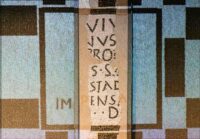 The oldest mosaic floor dates to the late 1st century B.C. and features black and white tiles arranged in a hexagonal pattern. The next two chronologically date to the second half of the 1st century A.D. and the beginning of the 2nd. A partial inscription (the black tiles that formed the letters were reused in later renovations) dates to the reign of Trajan (98-117 A.D.) and records three patrons of that particular mosaic pavement, suggesting it may have had a semi-public use at this time, as in for members of an association.
The oldest mosaic floor dates to the late 1st century B.C. and features black and white tiles arranged in a hexagonal pattern. The next two chronologically date to the second half of the 1st century A.D. and the beginning of the 2nd. A partial inscription (the black tiles that formed the letters were reused in later renovations) dates to the reign of Trajan (98-117 A.D.) and records three patrons of that particular mosaic pavement, suggesting it may have had a semi-public use at this time, as in for members of an association.
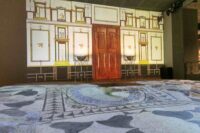 Black-and-white geometric mosaics from the era of Hadrian (117-138 A.D.) were found in good condition, but the real stand-outs are five mosaics dating to the Antonine dynasty (150-175 A.D.). These were the first ones encountered by the finders and they are dazzling in their array of iconographic elements and color accents. One floor has a black-on-white figure eight pattern that has never been seen before. A few painted walls from this phase have also survived.
Black-and-white geometric mosaics from the era of Hadrian (117-138 A.D.) were found in good condition, but the real stand-outs are five mosaics dating to the Antonine dynasty (150-175 A.D.). These were the first ones encountered by the finders and they are dazzling in their array of iconographic elements and color accents. One floor has a black-on-white figure eight pattern that has never been seen before. A few painted walls from this phase have also survived.
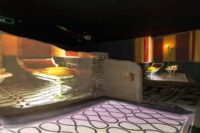 The Antonine mosaic floors undulate today, a result of centuries of earth movement culminating in structurally damaging subsidence that likely caused the abandonment of the villa in the early 3rd century. In addition to the floors of the domus, archaeologists discovered hundreds of artifacts including lacquered bowl fragments, a hairpin, a key and an amphora used to store garum, the fermented fish gut sauce that Romans put on everything.
The Antonine mosaic floors undulate today, a result of centuries of earth movement culminating in structurally damaging subsidence that likely caused the abandonment of the villa in the early 3rd century. In addition to the floors of the domus, archaeologists discovered hundreds of artifacts including lacquered bowl fragments, a hairpin, a key and an amphora used to store garum, the fermented fish gut sauce that Romans put on everything.
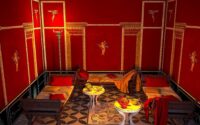 The excavation, conservation of the mosaics and walls in situ and the creation of an exhibit environment to allow the public access to the exceptional remains were privately financed by the developers of the complex who are happily using the extreme coolness of their ancient basement in their promotional materials. The Hadrianic and Antonine mosaics are on display, enhanced by a light projection system that fills in some of the blanks in the mosaics and visually recreates lost frescoed walls and furnishings of the domus. They’re calling it an archaeological treasure chest, opened to the public two days a month, then closed back up to protect it (and the luxury penthouse owners).
The excavation, conservation of the mosaics and walls in situ and the creation of an exhibit environment to allow the public access to the exceptional remains were privately financed by the developers of the complex who are happily using the extreme coolness of their ancient basement in their promotional materials. The Hadrianic and Antonine mosaics are on display, enhanced by a light projection system that fills in some of the blanks in the mosaics and visually recreates lost frescoed walls and furnishings of the domus. They’re calling it an archaeological treasure chest, opened to the public two days a month, then closed back up to protect it (and the luxury penthouse owners).
When can I move into their basement?
The villa is much nicer than the “luxury” condos.
Just stumbled on this blog. Really interested and kudos for the interesting articles. I just love history and especially this era.